Hesi a2 biology study gu - Study guides, Class notes & Summaries
Looking for the best study guides, study notes and summaries about Hesi a2 biology study gu? On this page you'll find 66 study documents about Hesi a2 biology study gu.
All 66 results
Sort by
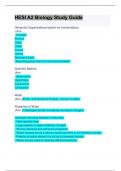
-
HESI A2 Biology Study Guide: Updated Guide Solution
- Exam (elaborations) • 13 pages • 2023
- Available in package deal
-
- $7.99
- + learn more
Hierarchic Organizational system for nomenclature (Ans- Kingdom Phylum Class Order Family Genus Species (Least) "Keep Penguins Cool Or Find Good Shelter" Scientific Method (Ans- Observation Hypothesis Experiment Conclusion Water (Ans- All life, and therefore biology , occurs in water. Properties of Water (Ans- 2 Hydrogen bonds Covalently bonded to Oxygen. Hydrogen Bonding between molecules. - High specific heat - Large bodies or water stabilize climates - S...
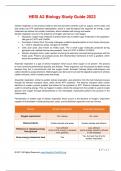
-
HESI A2 Biology Study Guide 2023
- Exam (elaborations) • 47 pages • 2023
- Available in package deal
-
- $12.99
- + learn more
HESI A2 Biology Study Guide 2023 Cellular respiration is the process inside of cells that converts nutrients (such as sugars, amino acids, and fatty acids) into ATP (adenosine triphosphate), which is used throughout the organism for energy. Large molecules are broken into smaller molecules, which releases both energy and waste. Aerobic respiration occurs in the presence of Oxygen and has four main stages: Glycolysis: Larger sugar molecule is broken down into 2 smaller sugar molecules in...
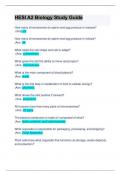
-
HESI A2 Biology Study Guide: Questions & Answers: Updated A+ Score Guide
- Exam (elaborations) • 13 pages • 2023
- Available in package deal
-
- $7.99
- + learn more
How many chromosomes do sperm and egg produce in meiosis? (Ans- 23 How many chromosomes do sperm and egg produce in mitosis? (Ans- 46 What helps the cell shape and cell to adapt? (Ans- cytoskeleton What gives the cell the ability to move and proper? (Ans- microtubules What is the main component of blood plasma? (Ans- water What is the first step in metabolism of food to cellular energy? (Ans- glycolysis What drives the cell/ pushes it forward? (Ans- propulsion ...
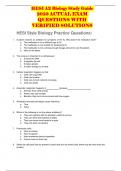
-
HESI A2 Biology Study Guide 2023 ACTUAL EXAM QUESTIONS WITH VERIFIED SOLUTIONS
- Exam (elaborations) • 48 pages • 2023
- Available in package deal
-
- $13.99
- + learn more
HESI A2 Biology Study Guide 2023 ACTUAL EXAM QUESTIONS WITH VERIFIED SOLUTIONS HESI Style Biology Practice Questions: 1. A patient receives an antibiotic for symptoms of the flu. Why doesn’t the medication work? a. The medication is for a different type of flu. b. The medication is not suitable for treating the flu. c. The medication is not a strong enough dosage amount to cure the patient. d. None of the above 2. The nucleus is important in a cell because: a. It stores the DNA ...
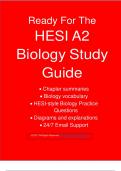
-
HESI A2 Biology Study Guide 2023
- Exam (elaborations) • 48 pages • 2024
- Available in package deal
-
- $15.49
- + learn more
HESI A2 Biology Study Guide 2023 Cellular respiration is the process inside of cells that converts nutrients (such as sugars, amino acids, and fatty acids) into ATP (adenosine triphosphate), which is used throughout the organism for energy. Large molecules are broken into smaller molecules, which releases both energy and waste. Aerobic respiration occurs in the presence of Oxygen and has four main stages: Glycolysis: Larger sugar molecule is broken down into 2 smaller sugar molecules in...

-
HESI A2 Biology Study Guide 2023
- Exam (elaborations) • 47 pages • 2023
-
- $10.99
- + learn more
HESI A2 Biology Study Guide 2023 Cellular respiration is the process inside of cells that converts nutrients (such as sugars, amino acids, and fatty acids) into ATP (adenosine triphosphate), which is used throughout the organism for energy. Large molecules are broken into smaller molecules, which releases both energy and waste. Aerobic respiration occurs in the presence of Oxygen and has four main stages: Glycolysis: Larger sugar molecule is broken down into 2 smaller sugar molecules in...
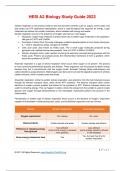
-
HESI A2 Biology Study Guide 2023
- Exam (elaborations) • 47 pages • 2023
-
- $10.99
- + learn more
HESI A2 Biology Study Guide 2023 Cellular respiration is the process inside of cells that converts nutrients (such as sugars, amino acids, and fatty acids) into ATP (adenosine triphosphate), which is used throughout the organism for energy. Large molecules are broken into smaller molecules, which releases both energy and waste. Aerobic respiration occurs in the presence of Oxygen and has four main stages: Glycolysis: Larger sugar molecule is broken down into 2 smaller sugar molecules in...

-
HESI A2 Biology Study Guide 2023
- Exam (elaborations) • 48 pages • 2024
- Available in package deal
-
- $14.99
- + learn more
HESI A2 Biology Study Guide 2023 Cellular respiration is the process inside of cells that converts nutrients (such as sugars, amino acids, and fatty acids) into ATP (adenosine triphosphate), which is used throughout the organism for energy. Large molecules are broken into smaller molecules, which releases both energy and waste. Aerobic respiration occurs in the presence of Oxygen and has four main stages: Glycolysis: Larger sugar molecule is broken down into 2 smaller sugar molecules in...
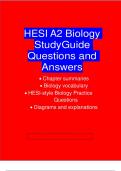
-
HESI A2 Biology Study Guide Questions and Answers
- Exam (elaborations) • 48 pages • 2023
- Available in package deal
-
- $15.39
- + learn more
HESI A2 Biology Study Guide Questions and Answers Cellular respiration is the process inside of cells that converts nutrients (such as sugars, amino acids, and fatty acids) into ATP (adenosine triphosphate), which is used throughout the organism for energy. Large molecules are broken into smaller molecules, which releases both energy and waste. Aerobic respiration occurs in the presence of Oxygen and has four main stages: • Glycolysis: Larger sugar molecule is broken down into 2 smaller sug...

How did he do that? By selling his study resources on Stuvia. Try it yourself! Discover all about earning on Stuvia


